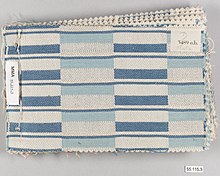Otti Berger
Berger’s Jewish family was granted unrestricted residence and freedom in religion under the rule of Emperor Franz Joseph I.Due to a previous illness, Berger suffered from partial hearing loss, which was said to have heightened or enhanced her sense of touch.[7] Along with Anni Albers and Gunta Stölzl, Berger pushed back against the understanding of textiles as a feminine craft and utilized rhetoric used in photography and painting to describe her work.[6] During her time in Dessau, she also wrote a treatise on fabrics and the methodology of textile production, which stayed with Walter Gropius and was never published.[7][3] It was a short-lived position, however, as she was replaced in 1932 by Lilly Reich, the partner of new Bauhaus director Ludwig Mies van der Rohe.[10] She fled to London in 1937, where she was able to support herself with sporadic design contracts,[8] including work with Helios Ltd and Marianne Straub."[8] Over the course of several years, Berger's attempts to emigrate to United States to work with her fiancé Ludwig Hilberseimer and other Bauhaus professors failed.[3] After several years spent with family, in April 1944 Berger was deported alongside her brother, half-brother, and his wife to a detention camp in Mohács.


Zmajevac, CroatiaAustria-HungaryAuschwitzPolandBauhausTextilesweavingtextile artistweaverthe HolocaustEmperor Franz Joseph IZmajevacAustro-Hungarian EmpireCroatiaAcademy of Fine Arts, University of ZagrebZagrebDessauLászló Moholy-NagyPaul KleeWassily KandinskyAnni AlbersGunta StölzlWalter GropiusLilly ReichLudwig Mies van der RoheLudwig HilberseimerAuschwitz concentration campBusch-Reisinger MuseumMetropolitan Museum of ArtArt Institute of ChicagoFriedl Dicker-BrandeisMargaretha ReichardIvana Tomljenović-MellerProject MUSEWayback MachineGetty CenterBasketweaveCharvetCoverletDouble weaveEven-weaveGabardineLampasLeno weaveOxfordPile weavePiquéPlain weaveSwivelWarp and weftBarber-Colman knotterBeamerChilkat weavingFingerweavingFlying shuttleHeddleInkle weavingKasuriNavajo weavingPibionesSalish weavingShuttleSizingSizing machineTablet weavingTānikoTapestryTempleWattleWickerAir-jet loomDandy loomDobby loomHattersley loomHorrocks loomJacquard loomLancashire loomNorthrop loomPower loomRapier loomRoberts loomWarp-weighted loomAcesasMicheline BeaucheminJohanna BrunssonAda DietzThomas Ferguson & Co LtdElisabeth ForsellDorothy LiebesEthel MairetMaria Elisabet ÖbergMargaretha ReichardtJohn RylandsBrigitta ScherzenfeldtClara ShermanJudocus de VosMargaretha ZetterbergMore loomsKissing the shuttlePiece-rate listBancroft ShedQueen Street Mill